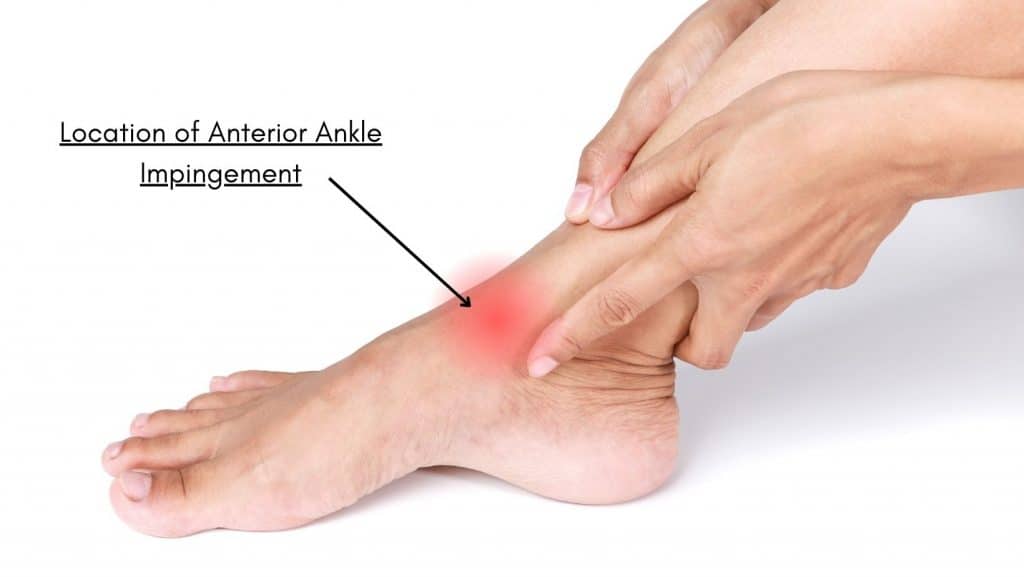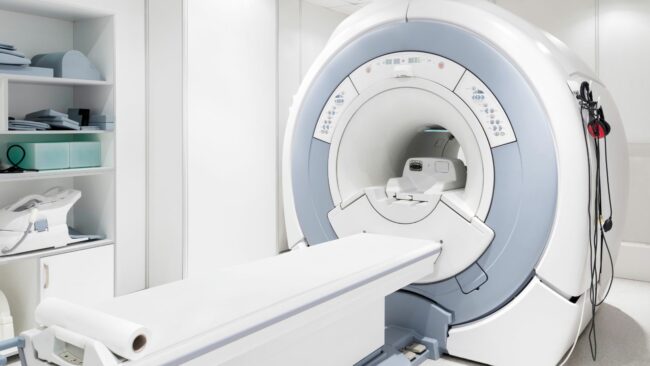Anterior Ankle Impingement Exercises
Read More >
Anterior Ankle Impingement is a broad term to describe different causes of pain in the front of the ankle joint. The anterior ankle joint is primarily made of 3 different bones: the talus, lateral and medial malleolus.
A capsule surrounds the joint, and numerous soft tissue structures such as tendons, ligaments and nerve endings overlap. If any of these structures become irritated or painful, it is called an Anterior Ankle Impingement.

The symptoms of Anterior Ankle Impingement are typically slow and progressive rather than an acute onset. There is often clicking at the front of the ankle when walking or rotating the foot.
It is painful to walk on uneven surfaces or uphill as this closes down the front of the ankle, leading to a pinching sensation. It is common for there to be no swelling at the front of the ankle, and in most cases, there is no bruising either.
Running and jumping are often painful, while kicking a ball can cause the front of the ankle joint painful. Symptoms are eased by plantarflexing the foot.

Repetitive overuse of the front of the ankle can irritate the soft tissue structures in this area, leading to pain and irritation. This is often seen in runners, footballers (Footballers’ Ankle) and ballet dancers. Constant use of these structures leads to inflammation and irritation of the tendons and ligaments in the area.
Continued irritation of the front of the ankle can lead to the development of a bony spur or osteophyte on one of the joint’s bones. The formation of these structures leads to mechanical impingement when the joint is closed in dorsiflexion, as the osteophyte can pinch the surrounding structures. Bone healing can also cause osteophyte formation from a fracture as the body creates an excess of new bone as part of the healing process.
Scar tissue can form in the front of the ankle, reducing the space for the joint to move and causing an impingement. This is often secondary to ankle surgery, such as ankle stabilisation after a dislocation. In other cases, cartilage lesions or osteochondral defects can cause pain when walking in the front of the ankle.
In rare cases, some people have an accessory ligament on the front of the ankle called Bassett’s ligament, an extension of the AiTFL ligament. In ankle dorsiflexion, the ligament can impinge with the talar dome.

Image from the National Library of Medicine: https://www.ncbi.nlm.nih.gov/pmc/articles/PMC35351
A Physical Therapist can diagnose an Anterior Ankle Impingement. Based on your symptoms, they can identify a pattern of pain and then carry out an Anterior Ankle Impingement test involving the therapist dorsiflexing and externally rotating the ankle; pain provocation indicates a positive test.
An MRI is the best form of imagining for an Anterior Ankle Impingement as it provides information on soft tissue structures and the integrity of the joint.
It is essential to get a complete picture of these structures as there can be multiple causes of anterior ankle impairment. An X-ray can be helpful to detect an osteophyte, but it cannot detect any soft tissue changes.

A significant amount of the pain from an Anterior Ankle Impingement derives from inflammation when the soft tissue structures are pinched at the front of the ankle. We recommend the following measures to reduce your pain levels at home.
A Physical Therapist is in an excellent position to treat an Anterior Ankle Impingement. Reducing pain and the critical aggravators of your symptoms is essential in the initial stages. They might tape your ankle for extra support and recommend a heel lift or ankle brace for additional stability.
After this, they should prescribe strength and mobility exercises to address imbalances and strength deficits in the ankle and lower leg. This should be a very graded rehabilitation protocol. It’s not unusual to have discomfort as you progress through the early rehabilitation phases.
Once strength and balance have improved, hopping, plyometric exercises, and sport-specific rehabilitation are typically introduced. For instance, if you are a keen runner, this may involve a running gait analysis or a volleyball player; they will assess your stability when changing direction at speed.
In some instances, Physical Therapy can struggle to reduce the pain levels associated with Anterior Ankle Impingement and an injection is required. In this instance, an ultrasound-guided steroid injection can reduce the inflammation within the joint. A period of 1-2 weeks in a boot can help optimise the effect of the injection if it is successful, a period of 4-6 weeks.
In cases where an injection is unsuccessful due to osteophyte formation or scar tissue impingement, then surgery can be recommended. This is usually an arthroscopy to clean the joint, followed by 6-12 weeks of Physical Therapy. These are usually successful procedures with a high return rate to normal function.
As a nonimpact form of exercise that is linear in motion, cycling is highly unlikely to cause Anterior Ankle Impingement. If you are experiencing Anterior Ankle Impingement when cycling, consider increasing the height of your saddle to decrease the dorsiflexion angle of the ankle.
Pointing the foot down and the bottom of the pedal stroke can also help to reduce any discomfort on the front of your ankle. Alternatively, consider increasing your saddle height or finally, you could try moving your seat backwards.
Anterior Ankle Impingement is primarily an inflammatory issue; if you continue aggravating it, it is unlikely to improve. If you have pain during or increases within 24 hours of a run, we recommend stopping running.
We recommend a stability trainer with a high heel drop of at least 10mm if you run with anterior ankle impairment. However, if you have no pain during or after a run, you can continue.
This article is written by James McCormack, a lower limb specialist who is an expert in treating ankle impairments.
This is not medical advice. We recommend a consultation with a medical professional such as James McCormack if you are experiencing any of the symptoms discussed in this article. James offers Online Physiotherapy Appointments weekly and face-to-face appointments in his London clinic.